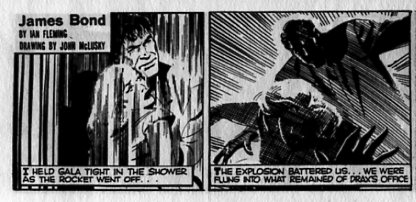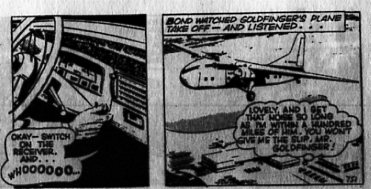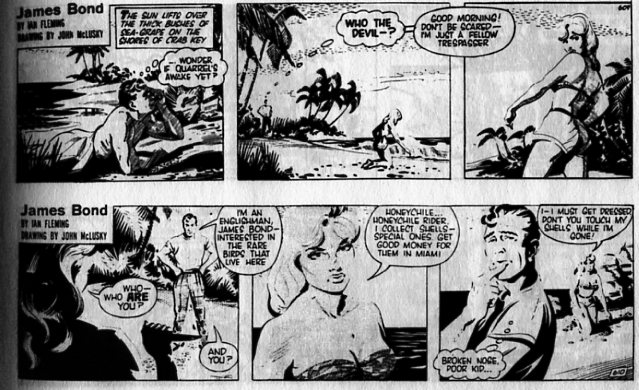This review first appeared at tcj.com. (Apologies for the lousy scans; I did the best I could, but it was pretty bad in this instance.)
________________
Adventure strip cartooning is basically dead, which makes sense, since I could never figure out how it managed to get up and walking around in the first place. This collection of James Bond newspaper serials from the late-50s and early-60s perfectly captures everything wrong with the form. Instead of a full-throttle adventure romp, you get a plot that stutters compulsively as it desperately tries to bring you up to speed week after week. Instead of pulse-pounding action-sequences, you’ve got images so small you can barely get a motion line in when you throw a punch. And instead of racy, PG-13 innuendo, you’ve got family-friendly not-too-skimpy bikinis — again, drawn at a size that means you need to squint to make an eyeful of the tame fare on offer.
None of which is to denigrate this collection, exactly. John McClusky is a very talented artist, especially adept with detailed linework and shading effects. He rarely gives you a sense of actual action or excitement (which, again, would be awfully hard to do in this format, anyway), but his best work can capture a freeze-frame constructivist drama. Either of these two panels, for example, could be great movie posters:
McClusky is also a fine draftsman, who seems to work very effectively from photoreference. He expertly captures cars, clothes, planes — the world of surface stuff you expect to have presented to you when you’re reading a shallow fantasy of the good life like James Bond.
And, of course, McClusky’s cheesecake, reduced and PG though it is, is thoroughly professional, though a bit lacking in personality. Most of the women in the stories are blandly good-looking, and they start to blur into one another after a while. The one exception is Honeychile from Dr. No. She’s supposed to be a simple nature child, and the slight bit of added characterization seems to frees McClusky to throw in a bit of voluptuous oomph.
All of which basically led me to wish that McClusky had done work which might showcase his talents at a larger size and in a less hamstrung narrative form. But those are the breaks, I guess.
As for those narratives themselves — they are what they are. Produced before the first Sean Connery movies, the touches of humor, technical wizardry, or simply competent plotting those films offered are largely absent here. Instead, Bond escapes death not through cleverness or gadgetry, but mostly through sheer luck; bombs just keep not quite killing him for some reason. He often comes across, no doubt inadvertently, as dumb and bumbling— more like a real spy than like a fantasy one, in other words.
The most noticeable difference between the strips and my (admittedly tenuous) memory of the books is that the strips carefully finesse Fleming’s vicious homophobia. Wint and Kidd from Diamonds Are Forever are here just good friends; Pussy Galore falls for Bond because that’s what girls do, not because he forcibly shows her the error of her lesbian ways. On the one hand, dropping the prejudice makes the strips much more palatable for a contemporary audience. On the other hand — homophobia was kind of what Fleming had to offer. When you remove the compulsive anxiety about manliness, there’s not a whole lot here. Except the art, of course.




———————-
Noah Berlatsky says:
…homophobia was kind of what Fleming had to offer. When you remove the compulsive anxiety about manliness, there’s not a whole lot here.
————————
Pah! Fleming was an outstanding pulp-adventure-type writer. (Not exactly literature, but pretty good for what it was.) With attitudes that were hardly particularly enlightened, but far from outrageously poisonous. (For example, in one scene Bond makes a piggish remark, but Fleming shows it as just done to provoke; shows Bond thinking that in actuality, he wouldn’t be remotely interested in a submissive woman who would be an “insipid slave.”)
Funny how you inflate a couple of isolated bits from his body of work — a line where a character (Felix Leiter?) says of Wint and Kidd, “some of those homos make the worst killers” (misquoted from memory), and the silly-ass male fantasy of Bond showing a good-looking lesbian that Men Are More Fun In Bed — into a massive pattern of “vicious” (same adjective you’d used to characterize Hergé’s “racism”; which, personally, I’d save for something like the KKK) homophobia.
————————-
All of which basically led me to wish that McClusky had done work which might showcase his talents at a larger size and in a less hamstrung narrative form. But those are the breaks, I guess.
————————–
Yes; Will Eisner said that, for him, having to draw a daily comic strip would’ve been like “trying to conduct an orchestra in a telephone booth.” Remarkable that adventure comic strips still managed to be so successful for so long.
McClusky’s art looks pretty good…
(though I preferred Yaroslav Horak’s more kinetic, angular style: http://tinyurl.com/3fzgopz , http://tinyurl.com/3fyulpo , http://tinyurl.com/3c82vdz )
…even if neither chap can hold a candle to Jim Holdaway of “Modesty Blaise.”
See, also:
http://en.wikipedia.org/wiki/James_Bond_%28comic_strip%29
http://www.ilovecomixarchive.com/J/James-Bond (From which came the Horak samples above.)
Both the Pussy Galore sequence and Wint and Kidd seem to me to be pretty vicious stereotypes. And they fit nicely into the Bond stories overwhelming concern with manliness (and into the series’ misogyny, for that matter.)
It is worth noting that Fleming himself wasn’t really keen on these, even at the idea stage.
http://jamesbond.wikia.com/wiki/Comic_Strips
And for my part, this art has nothing of the tone and feel of Fleming’s world. The differences between Fleming’s — rather effete in comparison — Bond and the Bond McClusky drew is particularly striking. Not all of the anxiety about masculinity comes from Fleming…
What makes Wint and Kidd “vicious stereotypes,” that they’re brutal killers who are also a gay couple? Why then, heterosexuality comes off far worse: every single other villain in the Bond books — ah, almost forgot good ol’ Rosa Klebb! — is hetero. (OK, some nice gays would’ve been appreciated; but those were different times, genre fare hardly devoid of stereotyping; recall, for instance, “the effeminate Levantine” in “The Maltese Falcon.”)
And what is “viciously stereotypical” about Pussy Galore?
(A search for data on whom brought out instead a batch of stuff re a Brit women’s wear store: http://www.pussygalorecardiff.com/ , http://www.yelp.co.uk/biz/pussy-galore-cardiff . Sic transit gloria mundi!)
————————–
In the novel, Pussy Galore is the only known woman in the United States who runs an organized crime gang. Initially trapeze artists, her group of performing cat-women, “Pussy Galore and her Abrocats,” were unsuccessful and were later trained as cat burglars.
Her group grew into a Harlem lesbian organization known as “The Cement Mixers”. Pussy Galore is herself a lesbian. In the novel, she has black hair, pale skin and the only violet eyes Bond has ever seen. She is in her thirties, her voice low and attractive. Pussy explains to Bond that she became a lesbian after she was sexually abused by her uncle at the age of 12…
—————————
Naive and non-PC, but hardly outrageous. (From http://en.wikipedia.org/wiki/Pussy_Galore .)
Fleming’s supposed misogyny is neatly dismissed by Kingsley Amis in his “The James Bond Dossier.”
—————————
Everyone remembers Bond girls as being impossibly perfect and the reviewers criticised Fleming for this. So Fleming tried an experiment. Domino had a short leg and, in another book, Honeychile Rider had a broken nose. What was the reaction? To quote Kingsly Amis (The James Bond Dossier, 1965, Jonathan Cape). “No sooner had Mr. Fleming set his harmless experiment in action, with the presumable object of showing that a non-one-hundred-percent-perfect heroine could still be attractive, than the critics were at him with accusations of morbid interest in deformity, covert hatred of women etc. Direct recourse to the text will correct these and other misconceptions.”
—————————-
From, believe it or not, “THE SHORT LEG DEVOTEE SITE”: http://reocities.com/RainForest/3040/stories/shlglit.htm
…And what makes for the Bond book’s “overwhelming concern with manliness,” that Bond is a fantasy-figure lover and fighter? That’s a virtual necessity for lead characters in action-adventure fare.
However, since I’m more interested in getting at the truth of things rather than “winning an argument,” after writing the above ran across some high-caliber ammo for your “concern with manliness” arguments at http://www.sensesofcinema.com/2009/feature-articles/james-bond-sexual-politics/ …
(No time to discuss the last, though; gotta feed the cats their lunch and get ready for work!)
Mike:
As per the specific point of the stereotype that us gays are cold-eyed, amoral killers is a trope, not just a twist to make a generic villain-type gay for spice. It’s all over old media, noir thrillers, etc. (God, Peter Lorre). In the real world, it’s still in use today by folks like Scott Lively with his breathless hate pamplet “the Pink Swastika.” His ideas are hugely influential in recent anti-gay hysterias in West Africa and Eastern Europe.
*The stereotype, it is a trope. I end up with a lot of word salad in these comments.
Yeah…citing Kingsley Amis to combat charges of misogyny is nicely self-refuting.
Pussy Galore is an angry lesbian who hates men; then Bond rapes her and suddenly she sees the error of her ways. She’s not a person; she’s a fantasy prop. I wrote about it at greater length here. I still find her, and Fleming’s portrayal of women in general, fairly despicable.
As I remember, Wint and Kidd are depicted as deviant and murderous (and in the movie, ridiculous) because of their homosexuality. Heterosexual villains don’t in general have their viciousness attributed to their heterosexuality, because heterosexuality is normal.
Saying that it was a product of the times doesn’t make it any less annoying or offensive now. It’s not like Fleming is such a great prose stylist or has anything else interesting to say that makes me feel like, oh, well, I want to read his books anyway even though he’s got these unpleasant political opinions. I can see that argument to some extent for Tintin, but Fleming isn’t anywhere near the artist Herge is, in any sense.
The effeminate pervert even shows up in the latest film, Quantum of Solace. The character’s name is Elvis; he’s thin and has a creepy bowl haircut. Is the homophobia of James Bond really up for debate? I take it as a truism.
Bond women are something of a polygynous fantasy: they’re there to be dominated, but independent enough that the patriarch is freed from nuclear familial responsibilities. Suppress ’em, love ’em and move on to the next.